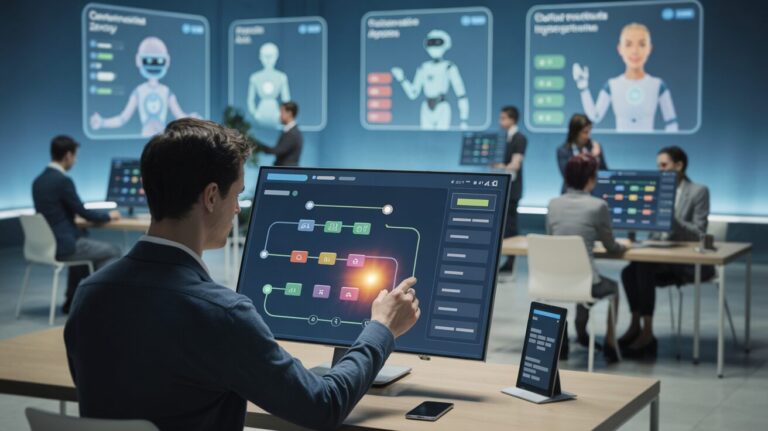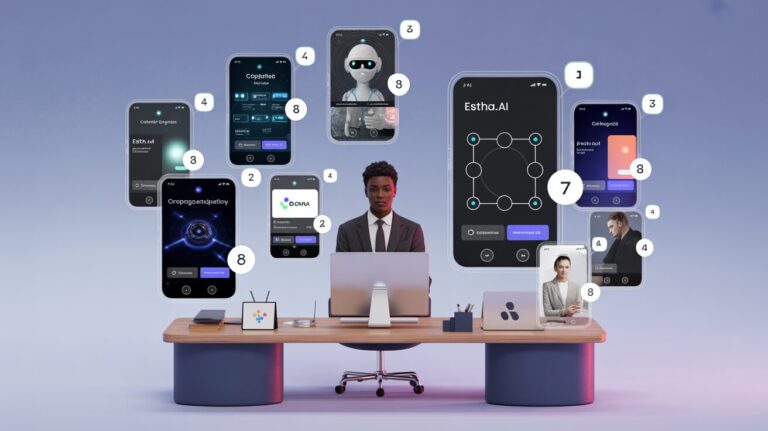Table Of Contents
- Understanding Personalised Learning in the Digital Age
- How AI is Revolutionizing Educational Pathways
- Key Components of Effective AI Learning Pathways
- Benefits of Personalised Learning with AI Assistants
- Real-World Applications Across Industries
- Creating Custom AI Learning Assistants Without Coding
- Overcoming Implementation Challenges
- The Future of Personalised Learning with AI
In today’s rapidly evolving educational landscape, one-size-fits-all approaches are quickly becoming relics of the past. The emergence of artificial intelligence has opened new frontiers in personalised learning, creating opportunities for tailored educational experiences that adapt to individual needs, learning styles, and goals. But what exactly does this mean for educators, trainers, and learners across different sectors?
Personalised learning pathways powered by AI assistants represent one of the most significant advances in educational technology of the past decade. These intelligent systems can analyze learning patterns, identify knowledge gaps, suggest custom content, and provide support exactly when needed—all while continuously evolving to better serve each individual learner.
The most exciting development? Creating these powerful AI learning assistants no longer requires deep technical expertise or coding knowledge. With the emergence of no-code platforms, professionals across industries can now design custom AI-powered learning experiences that reflect their expertise and teaching philosophy.
In this comprehensive guide, we’ll explore how personalised AI learning pathways work, their transformative benefits across different sectors, and how you can create your own custom AI learning assistants without writing a single line of code. Whether you’re an educator, corporate trainer, healthcare professional, or small business owner, you’ll discover practical ways to leverage AI to create more effective, engaging, and personalized learning experiences.
AI-Powered Personalized Learning
Transforming Education Without Coding Knowledge
How AI assistants are revolutionizing personalized education across industries
Intelligent Assessment
Continuous evaluation through natural interactions rather than traditional testing
Adaptive Content
Dynamic adjustment of materials based on learner progress and understanding
Personalized Support
24/7 feedback, guidance and help when learners need it most
Key Benefits Across Industries
Corporate Training
Role-specific learning tailored to existing knowledge
Healthcare Education
Personalized patient education and professional development
Small Business
Customer education that scales without additional staff
Create Your Own AI Learning Assistant: No Coding Required
Knowledge Capture
Organize your expertise
Design Interactions
Create engagement flows
Set Rules
Define personalization logic
Test & Deploy
Launch your AI assistant
The Future of AI-Powered Learning
Multimodal Learning
Dynamic adaptation of content format based on individual learning preferences
Lifelong Learning Companions
AI systems that evolve with learners throughout their educational journey
Understanding Personalised Learning in the Digital Age
Personalised learning represents a fundamental shift from traditional educational models. Instead of moving all learners through identical content at the same pace, personalised approaches recognize that each individual has unique strengths, weaknesses, interests, and optimal learning methods.
Traditional personalisation required enormous human resources—individual tutors or instructors spending significant one-on-one time with each student. This made truly personalised learning inaccessible to most people due to prohibitive costs and limited scaling potential. Digital technologies began changing this equation, but early attempts often amounted to little more than choosing from pre-determined paths rather than truly adaptive experiences.
The integration of artificial intelligence has revolutionized what’s possible. Modern AI-powered personalised learning pathways can:
- Continuously assess learner knowledge and skills
- Identify specific knowledge gaps and misconceptions
- Adapt content difficulty and pacing in real-time
- Present information in formats that match individual learning preferences
- Provide contextual support when learners struggle
- Recommend next steps based on performance and goals
These capabilities transform the learning experience from a linear progression to an intelligent, branching journey that evolves with each interaction. What makes this revolution particularly significant is how it democratizes access to high-quality personalised instruction that was previously available only to those with access to dedicated human tutors.
How AI is Revolutionizing Educational Pathways
AI assistants are fundamentally changing education through several technological capabilities that were either impossible or prohibitively expensive just a few years ago:
Intelligent Assessment
Unlike traditional testing that provides only periodic snapshots of knowledge, AI systems conduct continuous, low-stakes assessment through natural interactions. These systems can detect not just whether a learner has memorized facts, but whether they genuinely understand concepts through conversation-based assessments that feel more like discussions than exams.
Adaptive Content Delivery
Based on ongoing assessment, AI assistants can dynamically adjust what content is presented next. If a learner demonstrates mastery, the system might accelerate to more challenging material. Conversely, if misconceptions are detected, the AI might provide additional explanations, examples, or practice opportunities before moving forward.
Multimodal Learning Experiences
Different people learn differently. Some process information best through reading, others through visual representations, and still others through interactive experiences. Advanced AI learning pathways can identify individual preferences and present the same content in different formats to optimize comprehension and retention.
24/7 Support and Feedback
Perhaps the most transformative aspect of AI learning assistants is their constant availability. Learners can receive immediate feedback on questions, get help when stuck, and explore tangential topics of interest at any time—providing the kind of responsive support that even the most dedicated human educators cannot match at scale.
Key Components of Effective AI Learning Pathways
Creating truly effective personalised learning experiences with AI requires several integrated components working together:
Learner Profiles
Sophisticated AI learning systems build comprehensive profiles of each user, including prior knowledge, learning preferences, pace, interests, and goals. These profiles continually update and become more accurate with each interaction, enabling increasingly targeted personalisation.
Knowledge Graphs
Behind effective AI learning assistants lies a structured representation of domain knowledge—often called a knowledge graph. This maps relationships between concepts, prerequisites, and learning outcomes, allowing the AI to navigate pathways through the material that make logical sense based on the learner’s current understanding.
Natural Language Processing
The ability to understand and generate human language enables AI assistants to engage in meaningful conversations with learners. Advanced NLP allows systems to interpret questions, provide explanations, and assess understanding through dialogue rather than just multiple-choice quizzes.
Recommendation Engines
Similar to how streaming services recommend content, AI learning assistants use sophisticated algorithms to suggest the most relevant learning materials and activities based on the learner’s profile, goals, and previous interactions.
Benefits of Personalised Learning with AI Assistants
The advantages of AI-powered personalised learning pathways extend far beyond simple convenience:
Improved Learning Outcomes
Research consistently shows that personalised instruction leads to better comprehension and retention. When content is tailored to individual needs and delivered at the optimal pace, learners can achieve mastery more efficiently than with standardized approaches. AI assistants can identify and address misconceptions before they become entrenched, preventing the knowledge gaps that often undermine future learning.
Increased Engagement and Motivation
Learning experiences that adapt to individual interests and provide the right level of challenge help maintain motivation. Too easy, and learners become bored; too difficult, and they become frustrated. AI assistants can maintain this delicate balance, keeping learners in what psychologists call the “flow state”—engaged, challenged, but not overwhelmed.
Self-Directed Learning Skills
As learners interact with AI assistants that respond to their questions and interests, they develop stronger metacognitive skills and greater agency in their educational journey. Rather than passively consuming content, they become active partners in constructing their knowledge, developing critical thinking and self-assessment capabilities that serve them throughout life.
Inclusivity and Accessibility
AI learning pathways can adapt to diverse needs, including those of learners with disabilities or different cultural backgrounds. Content can be automatically modified to accommodate various learning differences, making education more accessible to everyone regardless of their starting point or special requirements.
Real-World Applications Across Industries
The potential of personalised AI learning assistants extends far beyond traditional educational settings:
Corporate Training and Professional Development
Organizations are increasingly implementing AI-powered learning platforms to onboard new employees, develop skills, and ensure compliance. These systems can adapt to each employee’s role, existing knowledge, and career goals, delivering precisely the training needed without wasting time on already-mastered content. For specialized fields requiring continuous learning, AI assistants can keep professionals updated on the latest developments relevant to their specific practice areas.
Healthcare Education
Medical professionals can benefit from AI assistants that help them stay current with rapidly evolving research and best practices. Patients, too, can receive personalised education about their specific conditions, treatments, and self-care routines—improving compliance and outcomes while reducing the burden on healthcare providers to repeat the same information multiple times.
Small Business and Customer Education
Small business owners can deploy AI assistants to educate customers about their products and services. Whether it’s helping clients understand investment options at a financial firm or teaching customers how to use a complex software product, these assistants can provide consistent, personalised guidance that scales effortlessly.
Lifelong Learning
Outside formal education or professional development, AI assistants can support personal learning goals—whether learning a new language, developing a hobby, or exploring a subject of interest. These systems can adapt to casual learning patterns that may be less structured than formal education but no less meaningful to the individual.
Creating Custom AI Learning Assistants Without Coding
The democratization of AI technology has made it possible for subject matter experts to create powerful learning assistants without programming knowledge. Using no-code platforms like Estha, professionals across industries can build personalized AI solutions that embody their expertise.
The process typically involves several key steps:
Knowledge Capture
First, you’ll need to organize your domain expertise in a structured way. Modern platforms simplify this through intuitive interfaces that help you map out concepts, relationships, and learning pathways without requiring technical knowledge of knowledge graphs or ontologies.
Designing Learning Interactions
Next, you’ll define the types of interactions your AI assistant will support. This might include explanatory dialogues, assessments, scenario-based learning, or guided practice. No-code platforms provide templates and visual builders for creating these interactions without writing code.
Personalisation Rules
You’ll then establish the rules for how your assistant adapts to different learners. This involves setting conditions (“if the learner struggles with X”) and corresponding actions (“then provide additional explanation Y”). Drag-and-drop interfaces make this logic accessible to non-programmers.
Testing and Refinement
Before full deployment, you’ll want to test your AI assistant with representative users and refine its responses and pathways based on their experiences. Many platforms provide simulation tools that let you role-play different learner types to verify appropriate responses.
Deployment and Integration
Finally, you’ll deploy your AI learning assistant where learners can access it—whether embedded in your website, integrated with existing learning management systems, or as a standalone application. No-code platforms typically provide simple integration options that don’t require technical expertise.
Platforms like Estha specialize in making this entire process accessible to non-technical creators through intuitive drag-drop-link interfaces. In as little as 5-10 minutes, subject matter experts can build AI learning assistants that embody their unique teaching approach and domain knowledge.
Overcoming Implementation Challenges
While creating personalized AI learning pathways has become more accessible, several challenges remain worth addressing:
Quality Assurance
Ensuring your AI assistant provides accurate information and appropriate guidance requires ongoing attention. Even with no-code platforms, creators should establish processes for regularly reviewing interactions and updating content as needed. The best platforms provide analytics that highlight areas where learners consistently struggle, indicating potential issues with the AI’s responses or content.
Balancing Structure and Flexibility
Effective learning pathways need enough structure to ensure comprehensive coverage of important concepts while remaining flexible enough to adapt to individual needs. Finding this balance requires thoughtful design that anticipates common learning paths while allowing for personalized detours based on interest or need.
Human Connection
AI assistants excel at providing information and guidance, but many learning experiences benefit from human connection and community. The most effective implementations combine AI-powered personalization with opportunities for peer interaction and access to human mentors when needed. Consider how your AI assistant complements rather than replaces human elements of learning.
The Future of Personalised Learning with AI
As AI technology continues to evolve, several emerging trends promise to further transform personalised learning:
Multimodal Learning
Future AI assistants will become increasingly sophisticated in adapting not just content selection but content format to individual learning preferences. Systems that can dynamically present information as text, visualizations, interactive simulations, or conversational explanations based on what works best for each learner will dramatically enhance accessibility and effectiveness.
Emotion-Aware Learning
Emerging AI capabilities in emotion recognition will enable learning assistants to detect when learners are confused, frustrated, bored, or engaged, and adapt accordingly. This affective computing dimension will make AI tutors more responsive to the full range of factors that influence learning beyond just knowledge gaps.
Collaborative AI Learning
While current AI assistants primarily support individual learning, future systems will increasingly facilitate collaborative learning experiences where multiple learners interact with both the AI and each other. These social learning environments will combine the benefits of personalization with the powerful learning that occurs through peer interaction.
Lifelong Learning Companions
Perhaps most transformatively, we’re moving toward AI systems that can accompany learners throughout their lives, building comprehensive understanding of their knowledge, interests, and learning patterns over decades rather than just within single courses. These lifelong learning companions will provide unprecedented continuity and personalization across educational experiences.
Conclusion: Embracing the Personalised Learning Revolution
Personalised learning pathways powered by AI assistants represent a fundamental shift in how we approach education and knowledge transfer across all sectors. By adapting to individual needs, learning styles, and goals, these systems make high-quality, tailored instruction accessible at a scale previously impossible.
The most exciting aspect of this revolution is that creating these powerful learning tools is no longer the exclusive domain of technical specialists. Subject matter experts across industries—educators, trainers, healthcare professionals, and business owners—can now build AI learning assistants that embody their unique expertise without writing code.
As we look toward the future, the potential for AI to transform learning experiences will only grow. Those who embrace these tools today, learning to effectively design and implement personalised AI learning pathways, will be well-positioned to lead educational innovation in their fields.
The barriers to entry have fallen. The question is no longer whether you have the technical skills to create AI learning experiences, but rather what unique knowledge you can share through these powerful new channels. In a world where information is abundant but personalized guidance remains precious, AI assistants offer a way to scale your expertise and impact like never before.
Ready to Create Your Own AI Learning Assistant?
Build a personalized AI learning experience that reflects your unique expertise—no coding required. Create interactive quizzes, expert advisors, and custom learning pathways in minutes.



